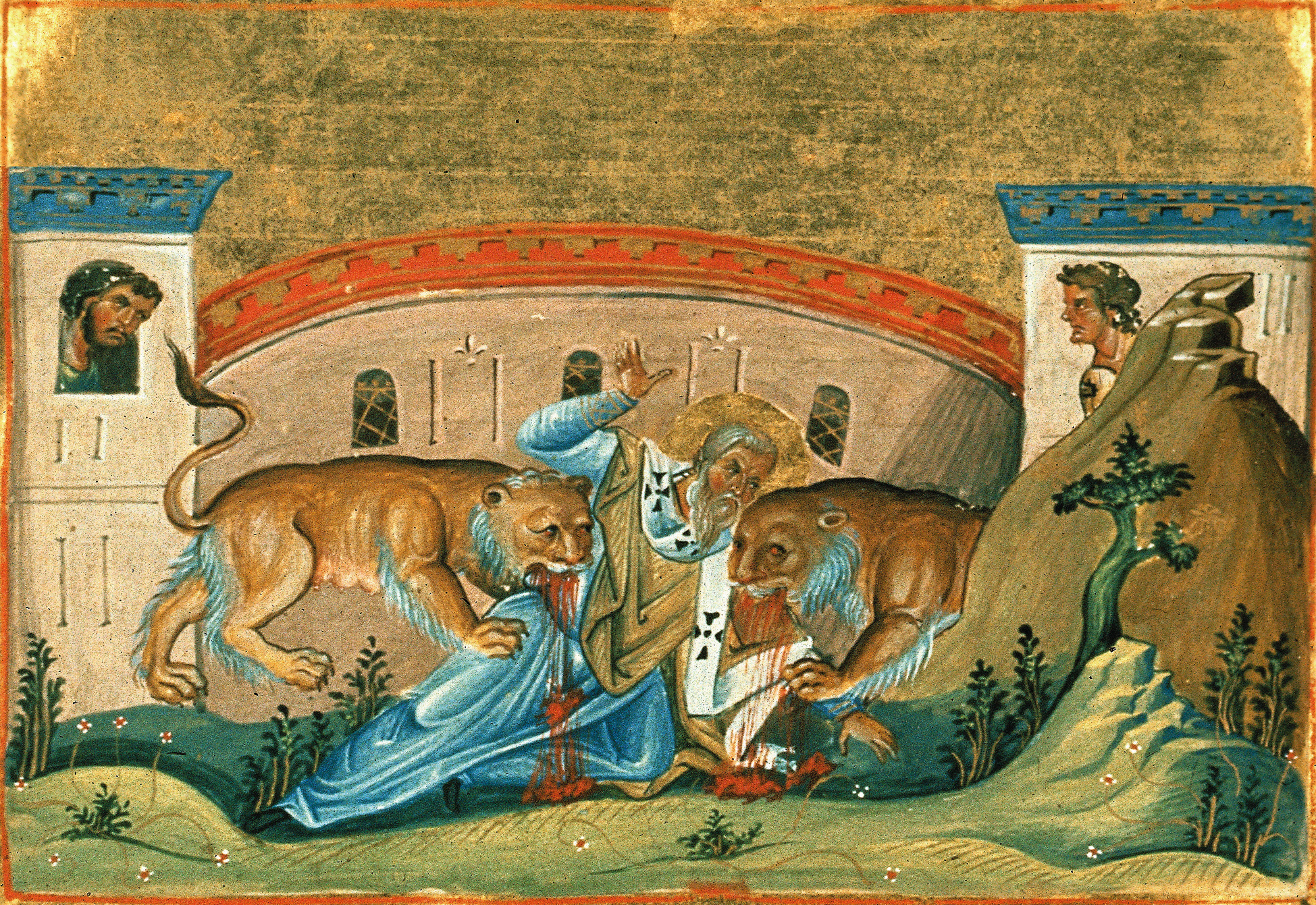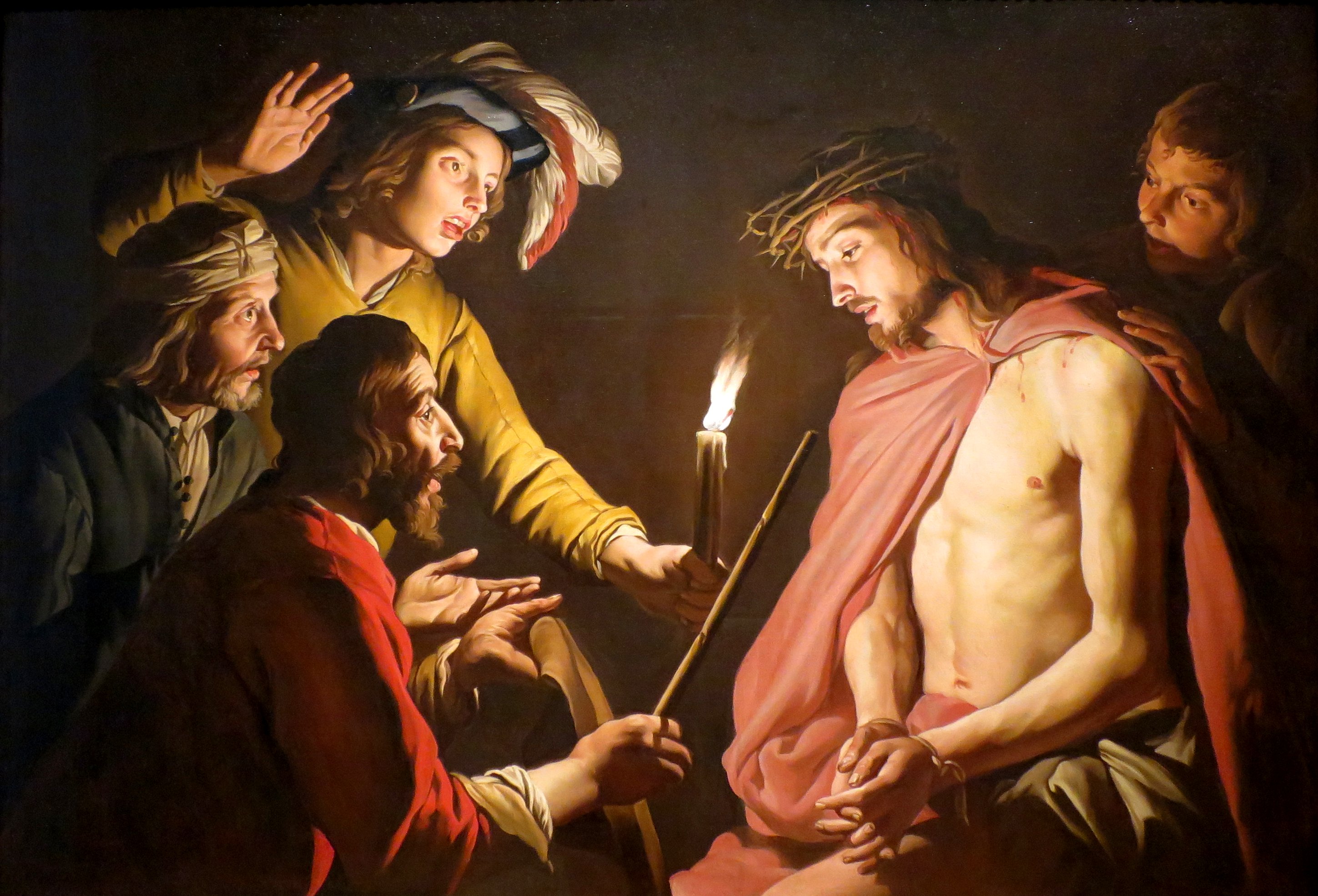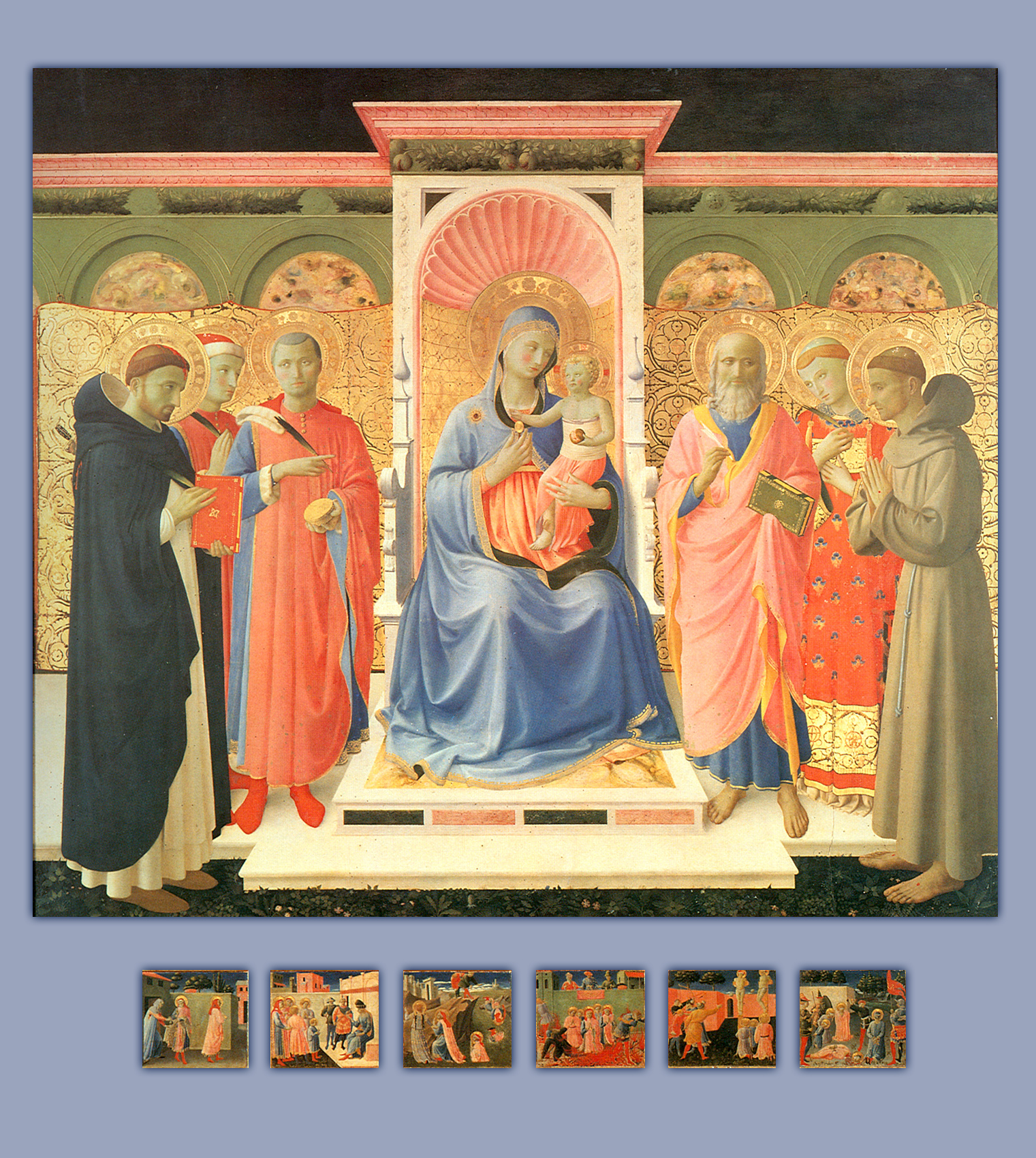|
Madonna With Child Between Sts. Flavian And Onuphrius
''Madonna with Child between Saints Flavian and Onuphrius'' is an oil-on-panel painting by Lorenzo Lotto, signed and dated 1508, now in the Borghese Gallery, in Rome. The painting was executed in the same year of the Recanati Polyptych, when Lotto moved to Rome (although it is not known if he had already painted it before leaving the Marche). It was first mentioned in a 1693 document, when it was already part of the Borghese Collection. Description The painting uses the Holy Conversation composition, with the Madonna and Child in the center between two saints, a scheme widely used by Giovanni Bellini and other Venetian painters of the time. It depicts, on a dark background, a thoughtful Madonna. The Child is rather fat, and is trying to reach St. Flavian of Ricina, painted on the left. The latter is offering Jesus a pierced heart, a symbol of the future Passion. The identification of Flavian, the patron of the city of Recanati in the Marche, is disputed, and some scholars iden ... [...More Info...] [...Related Items...] OR: [Wikipedia] [Google] [Baidu] |
Lorenzo Lotto
Lorenzo Lotto (c. 1480 – 1556/57) was an Italian painter, draughtsman, and illustrator, traditionally placed in the Venetian school, though much of his career was spent in other north Italian cities. He painted mainly altarpieces, religious subjects and portraits. He was active during the High Renaissance and the first half of the Mannerist period, but his work maintained a generally similar High Renaissance style throughout his career, although his nervous and eccentric posings and distortions represented a transitional stage to the Florentine and Roman Mannerists. Overview During his lifetime Lotto was a well-respected painter and certainly popular in Northern Italy; he is traditionally included in the Venetian School, but his independent career actually places him outside the Venetian art scene. He was certainly not as highly regarded in Venice as in the other towns where he worked, for he had a stylistic individuality, even an idiosyncratic style (although it fits w ... [...More Info...] [...Related Items...] OR: [Wikipedia] [Google] [Baidu] |
Recanati
Recanati () is a town and ''comune'' in the Province of Macerata, in the Marche region of Italy. Recanati was founded around 1150 AD from three pre-existing castles. In 1290 it proclaimed itself an independent republic and, in the 15th century, was famous for its international fair. In March 1798 it was conquered by Napoleon Bonaparte. The elongated historic center extends from one end to the other for over 200 metres and occupies an area of about 35 hectares. Its linear structure distinguishes it from most of the neighboring centers with a concentric plan, in which the inhabited area has extended from a central square. Along the margins of the central road, connecting the ancient housing clusters, there are numerous aristocratic buildings, for the most part on three floors, built by merchants or landowners. It is the hometown of the tenor Beniamino Gigli and the poet Giacomo Leopardi, which is why the town is known to some as "the city of poetry". Famous medieval Ashkenazi K ... [...More Info...] [...Related Items...] OR: [Wikipedia] [Google] [Baidu] |
Paintings Of The Madonna And Child By Lorenzo Lotto
Painting is the practice of applying paint, pigment, color or other medium to a solid surface (called the "matrix" or "support"). The medium is commonly applied to the base with a brush, but other implements, such as knives, sponges, and airbrushes, can be used. In art, the term ''painting ''describes both the act and the result of the action (the final work is called "a painting"). The support for paintings includes such surfaces as walls, paper, canvas, wood, glass, lacquer, pottery, leaf, copper and concrete, and the painting may incorporate multiple other materials, including sand, clay, paper, plaster, gold leaf, and even whole objects. Painting is an important form in the visual arts, bringing in elements such as drawing, Composition (visual arts), composition, gesture (as in gestural painting), narrative, narration (as in narrative art), and abstraction (as in abstract art). Paintings can be naturalistic and representational (as in still life and landscape art, lands ... [...More Info...] [...Related Items...] OR: [Wikipedia] [Google] [Baidu] |
Museo Thyssen-Bornemisza
The Thyssen-Bornemisza National Museum (in Spanish, the Museo Nacional Thyssen-Bornemisza (), named after its founder), or simply the Thyssen, is an art museum in Madrid, Spain, located near the Prado Museum on one of the city's main boulevards. It is known as part of the "Golden Triangle of Art", which also includes the Prado and the Reina Sofía national galleries. The Thyssen-Bornemisza fills the historical gaps in its counterparts' collections: in the Prado's case this includes Italian primitives and works from the English, Dutch and German schools, while in the case of the Reina Sofia it concerns Impressionists, Expressionists, and European and American paintings from the 20th century. With over 1,600 paintings, it was once the second largest private collection in the world after the British Royal Collection.Jonathan Kandell"Baron Thyssen-Bornemisza, Industrialist Who Built Fabled Art Collection, Dies at 81,"New York ''Times'', 28 April 2002. A competition was held to house t ... [...More Info...] [...Related Items...] OR: [Wikipedia] [Google] [Baidu] |
Christ Among The Doctors (Dürer)
The Finding in the Temple, also called Christ among the Doctors or the Disputation (the usual names in art), was an episode in the early life of Jesus depicted in chapter 2 of the Gospel of Luke. It is the only event of the later childhood of Jesus mentioned in a gospel. Gospel account The episode is described in . Jesus at the age of twelve accompanies Mary and Joseph, and a large group of their relatives and friends to Jerusalem on pilgrimage, "according to the custom" – that is, Passover. On the day of their return, Jesus "lingered", staying in the Temple, but Mary and Joseph thought that he was among their group when he wasn't. Mary and Joseph headed back home and after a day of travel realised Jesus was missing, so they returned to Jerusalem, finding Jesus three days later. He was found in The Temple in discussion with the elders. They were amazed at his learning, especially given his young age. When admonished by Mary, Jesus replied: "How is it that you sought me? Did y ... [...More Info...] [...Related Items...] OR: [Wikipedia] [Google] [Baidu] |
Onuphrius
Onuphrius ( el, Ὀνούφριος, Onouphrios; also ''Onoufrios'') lived as a hermit in the desert of Upper Egypt in the 4th or 5th centuries. He is venerated as Saint Onuphrius in both the Roman Catholic and Eastern Catholic churches, as Venerable Onuphrius in Eastern Orthodoxy, and as Saint Nofer the Anchorite in Oriental Orthodoxy. Life and legends Onuphrius was one of the Desert Fathers who made a great impression on Eastern spirituality in the third and fourth centuries, around the time that Christianity was emerging as the dominant faith of the Roman Empire. At this time many Christians were inspired to go out into the desert and live in prayer in the harsh environment of extreme heat and cold, with little to eat and drink, surrounded by all sorts of dangerous animals and robbers. It is uncertain in which century Onuphrius lived; the account of Paphnutius the Ascetic, who encountered him in the Egyptian desert, forms the sole source for our knowledge of the life of Sa ... [...More Info...] [...Related Items...] OR: [Wikipedia] [Google] [Baidu] |
Ignatius Of Antioch
Ignatius of Antioch (; Greek: Ἰγνάτιος Ἀντιοχείας, ''Ignátios Antiokheías''; died c. 108/140 AD), also known as Ignatius Theophorus (, ''Ignátios ho Theophóros'', lit. "the God-bearing"), was an early Christian writer and Patriarch of Antioch. While en route to Rome, where he met his martyrdom, Ignatius wrote a series of letters. This correspondence now forms a central part of a later collection of works known to be authored by the Apostolic Fathers. He is considered to be one of the three most important of these, together with Clement of Rome and Polycarp. His letters also serve as an example of early Christian theology. Important topics they address include ecclesiology, the sacraments, and the role of bishops. Life Nothing is known of Ignatius' life apart from what may be inferred internally from his letters, except from later (sometimes spurious) traditions. It is said Ignatius converted to Christianity at a young age. Tradition identifies ... [...More Info...] [...Related Items...] OR: [Wikipedia] [Google] [Baidu] |
Passion Of Jesus
In Christianity, the Passion (from the Latin verb ''patior, passus sum''; "to suffer, bear, endure", from which also "patience, patient", etc.) is the short final period in the life of Jesus Christ. Depending on one's views, the "Passion" may include, among other events, Jesus' triumphal entry into Jerusalem, his cleansing of the Temple, his anointing, the Last Supper, Jesus' agony in the Garden, his arrest, his Sanhedrin trial, his trial before Pontius Pilate, his crucifixion and his death on Good Friday, his burial, and the resurrection of Jesus. Those parts of the four canonical Gospels that describe these events are known as the "Passion narratives". In some Christian communities, commemoration of the Passion also includes remembrance of the sorrow of Mary, the mother of Jesus, on the Friday of Sorrows. The word ''passion'' has taken on a more general application and now may also apply to accounts of the suffering and death of Christian martyrs, sometimes using the L ... [...More Info...] [...Related Items...] OR: [Wikipedia] [Google] [Baidu] |
Borghese Gallery
The Galleria Borghese () is an art gallery in Rome, Italy, housed in the former Villa Borghese Pinciana. At the outset, the gallery building was integrated with its gardens, but nowadays the Villa Borghese gardens are considered a separate tourist attraction. The Galleria Borghese houses a substantial part of the Borghese Collection of paintings, sculpture and antiquities, begun by Cardinal Scipione Borghese, the nephew of Pope Paul V (reign 1605–1621). The building was constructed by the architect Flaminio Ponzio, developing sketches by Scipione Borghese himself, who used it as a '' villa suburbana'', a country villa at the edge of Rome. Scipione Borghese was an early patron of Bernini and an avid collector of works by Caravaggio, who is well represented in the collection by his ''Boy with a Basket of Fruit'', '' St Jerome Writing'', '' Sick Bacchus'' and others. Additional paintings of note include Titian's ''Sacred and Profane Love'', Raphael's ''Entombment of Christ'' and w ... [...More Info...] [...Related Items...] OR: [Wikipedia] [Google] [Baidu] |
Giovanni Bellini
Giovanni Bellini (; c. 1430 – 26 November 1516) was an Italian Renaissance painter, probably the best known of the Bellini family of Venetian painters. He was raised in the household of Jacopo Bellini, formerly thought to have been his father, but now that familial generational relationship is questioned.; “Giovanni Bellini: Birth, Parentage, and Independence" in ''Renaissance Quarterly'' An older brother, Gentile Bellini was more highly regarded than Giovanni during his lifetime, but the reverse is true today. His brother-in-law was Andrea Mantegna. Giovanni Bellini was considered to have revolutionized Venetian painting, moving it toward a more sensuous and colouristic style. Through the use of clear, slow-drying oil paints, Giovanni created deep, rich tints and detailed shadings. His sumptuous coloring and fluent, atmospheric landscapes had a great effect on the Venetian painting school, especially on his pupils Giorgione and Titian. Life Early career Giovanni ... [...More Info...] [...Related Items...] OR: [Wikipedia] [Google] [Baidu] |
Holy Conversation
In art, a (; plural: ''sacre conversazioni''), meaning holy (or sacred) conversation, is a genre developed in Italian Renaissance painting, with a depiction of the Virgin and Child (the Virgin Mary with the infant Jesus) amidst a group of saints in a relatively informal grouping, as opposed to the more rigid and hierarchical compositions of earlier periods. Donor portraits may also be included, generally kneeling, often their patron saint is presenting them to the Virgin, and angels are frequently in attendance. The term is often used as a title for paintings to avoid listing all the individual figures, although the trend in museums and academic art history is now to give the full list. The name, which only appears as a title retrospectively in the 18th century, has been explained with reference to "their rapt stillness of mood, in which the Saints, scarcely looking at one another, seem to communicate at a spiritual rather than a material level". At least that is the case i ... [...More Info...] [...Related Items...] OR: [Wikipedia] [Google] [Baidu] |



_grande.jpg)




